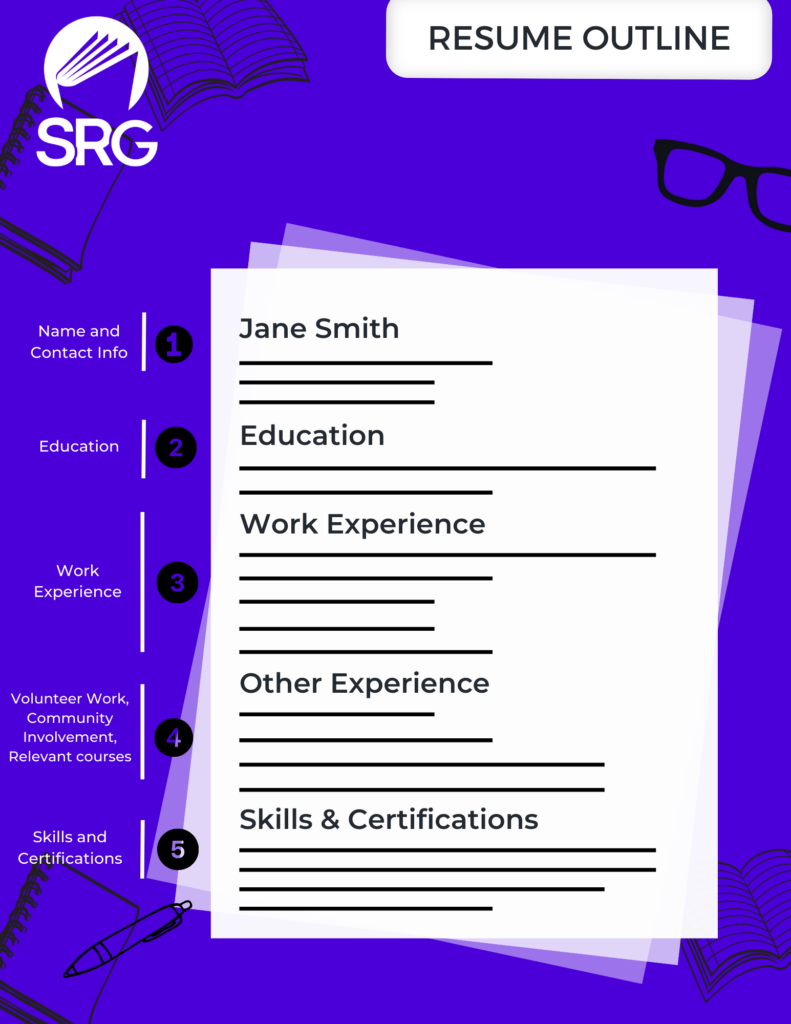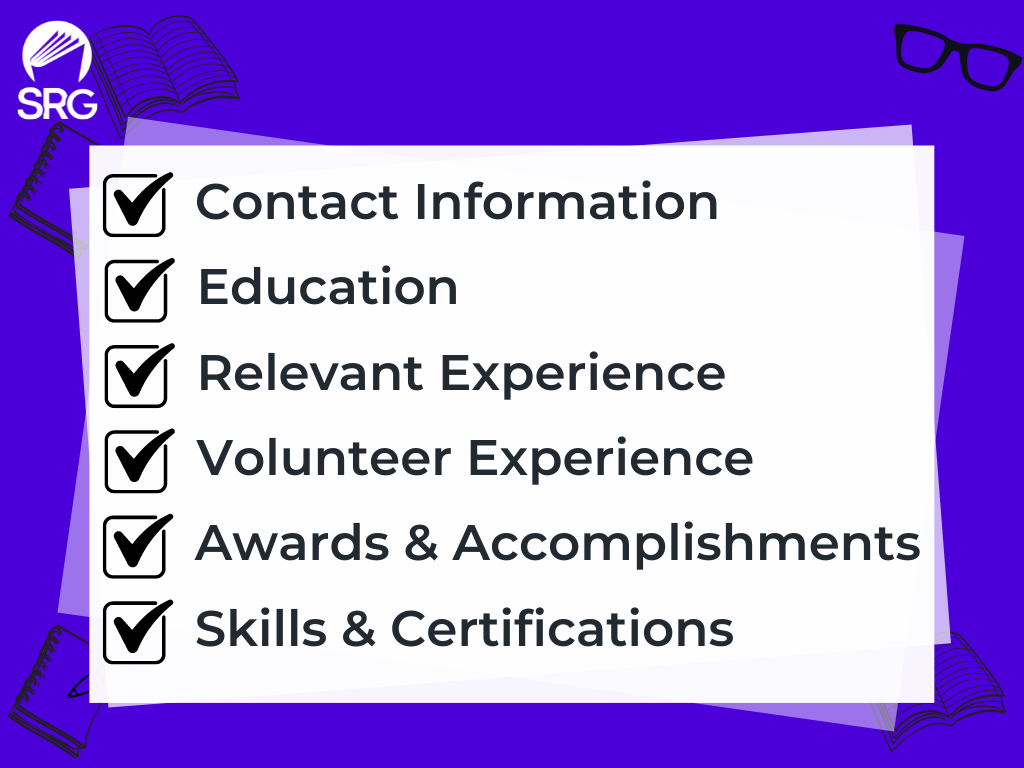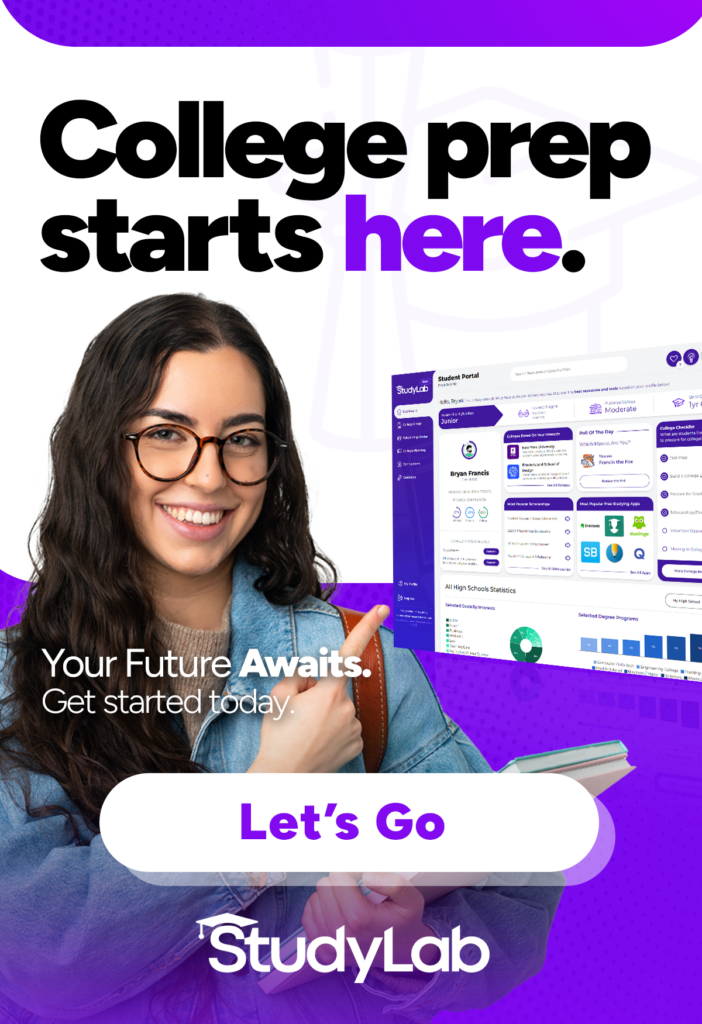Creating a resume can seem intimidating, especially when you’re a high school student. Trying to stand out from other candidates may seem like a challenge, especially if you have a limited amount of experience and education.
You may ask yourself, “Does a good resume really matter?” The answer is yes! After all, your resume will give colleges and employers a first impression of you. Building a high school resume for college or job applications can also help you start identifying your achievements and start practicing personal branding.
Here are our best resume tips for high school students, including what content you should include on your resume, how to design it, and other helpful tips and tricks for building your resume.
What should you include in your student resume?
A great resume begins with the right content. But, it can be difficult to know what to include—especially if you don’t have much experience. Here is the essential information that every student should have on their resume.
Contact Information
Your contact information should have its own section on your resume, usually at the very top. Within this section, you’ll want to include the following information:
Name
One of the first things employers should see on your resume is your name. Be sure to include it at the top of your resume and make it stand out with a larger font and/or bolded text.
Address
In many cases, you won’t need to include your address on your resume. For example, do not include your address on your resume if:
- You’re applying for a remote job where the location doesn’t matter.
- The job you’re applying for would require you to move prior to starting.
However, you can (and should!) include your address on your resume if:
- You’re applying to a local community college.
- You’re applying to an in-state college or university.
- You’re applying for a local, in-person job.
Phone Number
If an employer selects you for an interview, they’ll need to be able to reach you! Always include a phone number at the top of your resume—usually below your name—so it’s easy to spot.
Email Address
Similar to your phone number, you should include your email address to make it easy for employers to contact you. If you’re using an old email address with a less-than-professional username, it may be good to make a new account with a more professional email address.
LinkedIn profile URL
If you haven’t done so already, create a LinkedIn profile! LinkedIn is a great way to organize your experience and connect with people. Including your LinkedIn profile URL on your resume can help you build your personal brand and help employers get to know you better. If you need help getting started, LinkedIn’s blog has some great tips to build a better LinkedIn profile!
Education
Since your education is essentially your most recent experience, it’s best to place it at the top of your resume until you gain more experience in the workforce. This placement signals to employers that you are just beginning your professional journey. Here are some things you should include in the education section of your resume.
Name of School
If you’re a current high school student or recent graduate, listing the name of your high school first on your resume is generally considered best practice when formatting the information. If you have attended more than one high school, be sure to list the high school where you will be receiving your diploma at the top, since resumes are expected to be in reverse chronological order.
City of School’s Location
Including the location of your high school provides context for employers about where you live. If you are applying for a position that is local to where you live and attend school, then it’s an opportunity for the employer to connect with you and the community you share.
Degree Awarded
Even if it’s just your diploma, listing the degree type on your resume as “High School Diploma” is a good idea. Once you have started college or higher education, then you can remove your high school information from the education section and update it to have your most current education.
Graduation Date (or Expected Graduation Date)
Whether you are still in high school or have recently graduated, including the month and year of your expected graduation date can be helpful to include on your resume.
Additional Information
If your GPA is above a 3.0, then consider including it on your resume to show employers what kind of student you are. Other information that can be good to include are any AP classes you are taking and any major projects you have completed in a class.
Work Experience
Building a resume with little experience is possible. Whether you have experience babysitting, doing yard work for a neighbor, or working as a temporary assistant, it’s okay to get creative. You may not have a lot of experience, but that is normal at this stage. Just remember that, when possible, you apply the relevant experience you gained from previous positions to the new position you are applying for.
Position Title
Provide the title that you were given by the company or individual that previously hired you. If no formal title was given, then provide an accurate title that reflects the responsibilities you were assigned.
Name of Company
The company that employed you is important to include on your resume because brand recognition provides credibility. If there was no formal company name, then provide an appropriate name or two-word description to help employers understand your experience.
Start Date and End Date (or Present)
When an employer looks at your resume, they like to know how long you’ve held each position. Having the start date (month and year) as well as the end date shows the length of time that you held that position. If you are still working at one of the positions you list on your resume, then include the start date and put the end date as “Present.”.
List of Tasks or Responsibilities
When listing the tasks or responsibilities you’ve accomplished, it is best to structure your sentences with bullet points. Provide 3-5 bullet points of various tasks you completed or examples of what you achieved during your time in that position. When possible, provide statistics or numbers to show your credibility and the value you brought.
Other Experience to Include
Providing additional information on what you have accomplished in your academic and/or professional experience is another opportunity for you to showcase your skills and your unique background. It’s also another way to fill up your resume so there is less white or blank space.
Volunteer Experience
Have you volunteered at a food bank or a church? Put it on your resume! Volunteer experience can show employers that you are involved in your community and can help them get to know you. Looking for more volunteer opportunities? Check out StudyLab to browse great volunteer opportunities to add to your resume.
Awards and Achievements
Focus on awards that are recent and you received within your time in high school. List any honor societies that you have been involved with to show the connections you’ve made.
Relevant Skills, Courses, and Certifications
Providing a list of skills, courses, and certifications can showcase your unique experience and help you stand apart from other applicants. Keep in mind that you should add skills and qualities that align with your experience and are relevant to the job you are applying to.
Hard vs. Soft Skills
Having a combination of hard and soft skills can provide employers with more insight into your abilities. Examples of hard skills could include specific procedure knowledge, platforms, or software you know how to use like Google Suite, Microsoft Office, or specific social media platforms. Soft skills are more personal to who you are as a person and how you work. Examples of soft skills include written and verbal communication skills, copywriting, problem-solving, and more.
Courses
Besides the classes you are taking in school, exploring and taking online courses can help prepare you for your future. There are numerous courses available online and many are free! If you are interested in taking free courses online, there are many websites that offer information on free online courses.
Certifications
Having certifications on your resume is a great opportunity to show employers your accomplishments and that you are willing to go the extra mile. Whether the certification is relevant to the job or something you completed to expand your learning, including it on your resume can set you apart from the other candidates.
Now you know what to include in your student resume! The next step is to learn how to format all of your information on your resume so it’s presentable. Here are our best tips for formatting and designing your resume.
How to Format and Design Your Resume
Organizing your resume so that it’s easy to read and understand is just as important as the content itself. If the information on your resume is hard to follow or confusing, then the employer may disregard it. To ensure that your resume stands out and makes an impression, follow these formatting and design best practices.
Formatting
When formatting your resume, it is important that your information is organized with clear, specific sections. To get a better idea of what order to format your information, follow our recommended section order.
Recommended Section Order:

Contact Information
Starting at the top of your resume, place your contact information in the header of your resume.
Education
For students or recent graduates, your education section should be listed first but can move down on your resume once you have more work experience.
Relevant Experience
After education, list your relevant experience in reverse chronological order with the most recent at the top.
Other Experience
List volunteer experience, community involvement, and awards towards the bottom of your resume.
Skills, Courses, and Certifications
Present your skills, courses, and certifications at the very bottom of your resume.
Check for proper Grammar and Verb Tenses
Making sure you are using proper grammar is important because it shows employers that you can communicate clearly and are detail-oriented. A proofreading tool like Grammarly can help you catch errors you may otherwise have missed.
Another important tip is to make sure to use correct verb tenses. If you are no longer at a job that is listed on your resume, make the verbs past tense when describing what you did. On the other hand, you should use present tense verbs to describe a position you currently hold.
Use the Bold Feature
To make important headers and information stand out, use the bold feature. When specific keywords are in bold, it helps the information “pop out” to employers when they are reviewing your resume.
Space Out Information
On your resume, have your sections be organized and spaced out. If your information is clustered together with no clear, separated sections, then it may look unprofessional and could be overlooked by employers.
Choose a readable Font Style and Size
Use a font style on your resume that is easy to read and professional, so skip the Comic Sans. Some good font styles to use are Times New Roman, Calibri, Arial, Helvetica, Garamond, or Verdana. For font size, we recommend sticking with 11 or 12pt for normal text and then using 13, 14, or 15pt for titles of different sections. If the font size of your resume is too small, then it can be hard for employers to read.
Design and Personalization
Add Color
Adding a pop of color can help certain sections of your resume to stand out. But don’t go overboard with color, as this can quickly become distracting if you use too much or more than one color. If you do decide to add color, make sure it will still be easily readable if an employer prints it out. Pastels and yellow, for example, won’t show up well on printer paper.
Creative Language
Get creative when describing your tasks or accomplishments. Use creative language and a variety of action verbs to highlight your success. Having your tone of voice present in your resume can help employers get to know your personality through your writing.
How to Submit Your Resume: Best Practices
Proofread, proofread, proofread!
After you have completed writing and organizing your information, review your resume to make sure you have no misspelled words or sentences that don’t make sense. Get a second set of eyes and ask a teacher, parent, or someone you trust to review your resume and provide feedback.
Naming Your Resume
When naming the file document that you will attach to your application, make sure to not just title your document “resume” or your name. Consider including relevant information like your name, the position you are applying for, the word “resume”, and the year.
Examples include:
- Jane_Doe_Resume
- JaneDoe_Resume_2024
- JaneDoe_BakeryAssociate_Resume
- JaneDoe_BakeryAssociate_Resume_2024
Choosing a File Type
Follow the job application instructions of what type of document format they would like you to use for submission. If they don’t provide a document type preference, the safest option is to upload your resume as a PDF. Submitting a PDF ensures that your formatting stays intact and your file remains easily accessible regardless of the potential employer’s document viewing software.
Frequently Asked Questions and Common Misconceptions
Should I include an objective or summary statement on my resume?
Objectives on resumes used to be very common on resumes but are widely considered outdated now.
Once I create my resume, is my resume all done?
No, it is ideal to refresh your resume a least twice a year to keep it updated. As you gain more experience, updating your resume with current information periodically can save you the hassle of remembering everything you have previously accomplished.
Another important note: When you are applying for jobs, the job description may list some responsibilities or qualifications that may not be highlighted in your resume. It’s a good idea to carefully read through the job description and then update your resume to reflect some of the key responsibilities or qualifications that you have experience with.
Should my resume include a picture of myself?
It is usually best not to include a picture for several reasons:
1. The interviewer may be biased and make a snap judgment based on your picture (Sad, right?)
2. Depending on how you save and download your document, the file image may not save correctly and may result in an error when the interviewer looks at it—making your resume look unpolished. However, performing arts jobs may explicitly require headshots. It all depends on what jobs you apply for!
Does my resume need to include references?
While it is good to have references, having their information on your resume isn’t needed. More and more employers are not contacting references while completing the job hiring process. To be on the safe side, have at least three references and their contact information available to give to employers should they request it, just don’t include it on your resume.
Should my resume’s design be “bare bones” or be creative with many design elements?
Having a balance of both design styles is recommended. You shouldn’t go overboard with design on your resume but it also shouldn’t just be “bare bones.” Many employers run resumes through an automated application tracking system (ATS) and having too many design elements may get your resume rejected. Unless you’re applying for graphic design roles, it’s best to keep it relatively simple.
How long should a good resume be?
One page! A resume that is two or more pages long is a lot for an employer to read, especially when you don’t have much professional experience. Employers just need a one-page resume that contains your recent experience and details how that experience makes you the right candidate for the job.
Resume Checklist for Students
Now that you know what to include on your resume, how to design it, and other helpful tips—it’s time to start drafting your own resume! Even if you haven’t started looking for jobs or started applying for colleges, it’s still a good idea to be proactive and have all your information ready for when you do need it.
Want to include all the right information on your resume? Use our checklist below to make sure that your resume includes everything you need.

With an organized and well-worded resume, you will be able to stand out and make an impression with colleges and employers. Remember that your resume may not look the same as everyone else’s. After all, your experiences are unique and reflect your personality, knowledge, and experience. As you continue in your education and professional journey, your resume will evolve and grow.
To help get started thinking about your next steps and experiences after high school, sign up for StudyLab. Use StudyLab to find volunteer opportunities to add to your resume, explore various colleges across the U.S., and discover helpful resources and certifications to advance your learning.


